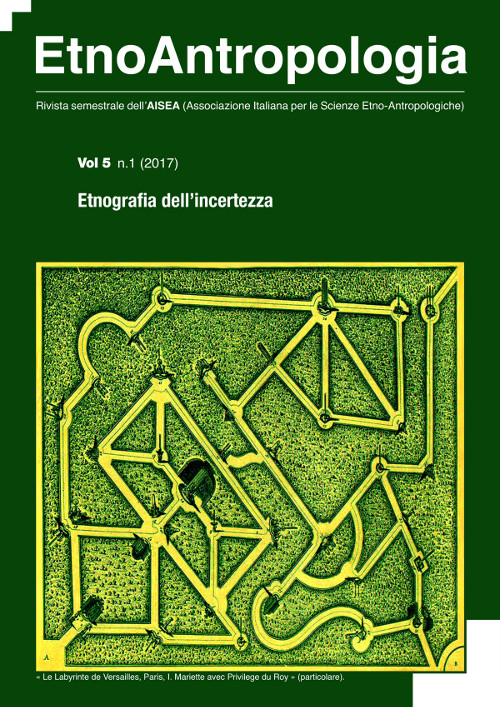Immagini migranti, immagini in-discriminanti Latenze e valenze nell’uso di foto e filmati in ambito migratorio
DOI:
https://doi.org/10.1473/235Parole chiave:
Portrait, stereoscopy, movie camera 16mm, class discrimination, visual fetish, photography and credibilityAbstract
Pictures, stereoscopies and films were some of the tools that the emigrants used, when they could afford them, as a form of support or an alternative to the exchange of letters. They were a mean to better define their new status of citizens of the world, who freed themselves from the poverty of the rural and southern contexts they left. The fixed, stentorian lapidary and three-dimensional image depicted in these portraits, seemed to provide the illusion to cross the threshold of overseas metropolis or of any other place on earth. It was a cinematographic image, therefore one in motion, in the end a more realistic picture which gave to the emigrants the opportunity to show off the success of their migratory project, had it actually been realized or not.
They gathered from the urban contexts where they settled down, all the necessary and technological know-how to convey, sometimes autonomously, as an amateur photographer or film maker, the winning image they wanted to send back home and project on the village walls on occasion of one of their “well planned” trips back. On these occasions, once again, the picture was necessary to strengthen their image of successful people. If on one side they meant to mark the distance from their fellow coutrymen, who had remained back at the village, at the same time they considered them as the recipients of their visual messages; denoting hence, the continuing of a relationship with them.
Through the study of some cases dating back to the first half of the twentieth century, in several parts of the Italian region of Basilicata, we try to make an analysis of the specific visual and audiovisual languages adopted by some emigrants whose aim was to portray an image of themselves described with an extreme care and meant to fuel a dynamic of both parting and approaching their place of origin.
Riferimenti bibliografici
Baldi A. 1999, Vite di giocattoli. Una ricerca sull’universo ludico lucano, Napoli: Electa: 117-125.
--2004, Scatti per sognare. Avigliano nelle fotografie dell’archivio Pinto, Napoli: Electa.
--2010, Storia della fotografia familiare e sociale lucana. Linee di ricerca ed esiti, in Mirizzi F. (ed), Da vicino e da lontano. Fotografi e fotografia in Lucania, Milano: Franco Angeli, 57-71.
Barthes R. 1980, La camera chiara, Torino: Einaudi.
Calvi G., 1899, Senza patria, Valenza Po: Battezzati.
Canclini N. G. 1998, Culture ibride. Strategie per entrare e uscire dalla modernità, Milano: Guerini.
Cresci M., Mazzacane L. 1983, Lezioni di fotografia, Bari: Laterza.
D’Anzi C. 2014-2015, Emigrante e cineasta. Cinematografia e fotografia nell’esperienza migratoria di un lucano in America, tesi di laurea in Antropologia culturale, Corso di laurea in Sociologia, Università degli studi di Napoli Federico II, relatore A. Baldi.
Donda E. 1983, Metafore di una visione. Ὄντον-λόγοσ-ἔιδοσ, Roma: Kappa.
Faeta F. 2010, La costruzione della diversità. Per una lettura delle rappresentazioni fotografiche nella Lucania del secondo dopoguerra, in Mirizzi F. (ed) 2010, Da vicino e da lontano. Fotografi e fotografia in Lucania, Milano: Franco Angeli, 21-32.
Faranda L., Lombardi Satriani L.M. 1988, Memoria e autorappresentazioni nello scambio di immagini fra nuclei familiari di immigrati italiani all’estero, in Pitto C. (ed) 1988, Per una storia della memoria. Antropologia e storia dei processi migratori, Crotone: Jonica, 159-201.
Fondi M., Franciosa L., Pedreschi L., Ruocco D. 1964, La casa rurale nella Campania, Firenze: Olschki.
Franciosa L. 1942, La casa rurale nella Lucania, Firenze: Olschki.
Geffroy Y. 1990, Family Photographs: A Visual Heritage, «Visual Anthropology», vol.3, n° 4: 367-409.
Goldberg V. 1995, The camera and the immigrant, in Ollman A., Goldberg V., A Nation of Strangers, San Diego: Museum of Photographic Arts, 21-27.
Huhtamo E. 2013, Illusion in Motion. Media Archeology of the Moving Panorama and Related Spectacles, Cambridge: Mit Press.
Levi Strauss D. 2007, Politica della fotografia, Milano: Postmedia.
Lucas U. 1977, Emigranti in Europa, Torino: Einaudi.
Mäkiranta M. 2012, Photography as Family Ritual: Visual Narratives in a Finnish Family Photo Album, «Visual Culture & Gender», vol. 7: 39-48.
Marano F. 1994, Aspetti antropologici nelle immagini di Nicola De Carlo pioniere della fotografia in Ruoti, «Lares», 4: 563-574.
Mattioli F. 1991, Sociologia visuale, Torino: NUOVA ERI.
Mirizzi F. (ed) 2010, Da vicino e da lontano. Fotografi e fotografia in Lucania, Milano: Franco Angeli.
Moricola G. (ed) 2008, Il viaggio degli emigranti in America latina tra Ottocento e Novecento. Gli aspetti economici, sociali, culturali, Napoli: Guida.
Ollman A., Goldberg V. 1995, A Nation of Strangers, San Diego: Museum of Photographic Arts.
Pitto C. (ed) 1988, Per una storia della memoria. Antropologia e storia dei processi migratori, Crotone: Jonica.
Riviello R. 1893, Ricordi e note su costumanze, vita e pregiudizii del popolo potentino per Raffaele Riviello, Potenza: Garramone e Marchesiello.
Sandbye M. 2014, Looking at the family photo album: a resumed theoretical discussion of why and how, «Journal of Aesthetics & Culture», vol. 6, http://dx.doi.org/10.3402/jac.v6.25419
Schawrtz D. 1989, Visual Ethnography: Using Photography in Qualitative Research, «Qualitative Sociology», vol. 12, n°2: 119–154.
Signorelli A. 2006, Migrazioni e incontri etnografici, Palermo: Sellerio.
Titus S. 1976, Family Photographs and Transition to Parenthood, «Journal of Marriage and Family», vol. 38, n° 3: 525-530.
Wade J. 1980, Breve storia della macchina fotografica, Roma: Ciapanna.
Pubblicato
Come citare
Fascicolo
Sezione
Licenza
Gli autori mantengono i diritti sulla loro opera e cedono alla rivista il diritto di prima pubblicazione dell'opera, contemporaneamente licenziata sotto una Licenza Creative Commons - Attribuzione che permette ad altri di condividere l'opera indicando la paternità intellettuale e la prima pubblicazione su questa rivista.
Gli autori possono diffondere la loro opera online (es. in repository istituzionali o nel loro sito web) prima e durante il processo di submission, poiché può portare a scambi produttivi e aumentare le citazioni dell'opera pubblicata (Vedi The Effect of Open Access).





